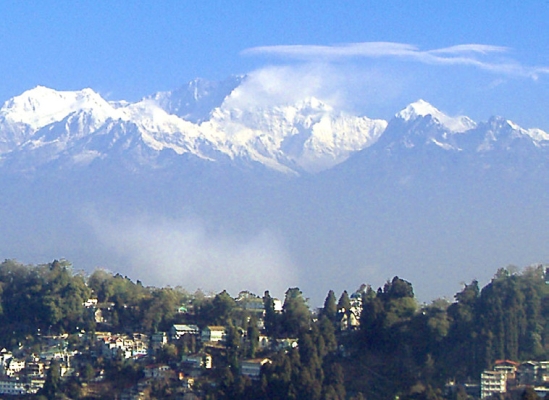Darjeeling
Text and photo by Edmund Jonah
Darjeeling – those three syllables should stir magic emotions in anyone who pronounces them. A small town perched six and a half thousand feet (1,981 meters) on an Himalayan hillside, opposite the world's highest mountain range, dominated by Kanchenjunga. This mountain with the sleeping face of Buddha is the third highest in the world. Nine of the top ten highest are in the Himalayan range, starting with Everest at 29,029 ft. (8,848 meters) while Kanchenjunga is 28,169 ft. (8,586 meters). The odd one out is called K2 at 28,251 ft. (8,611 meters) of the Karakoram Range, which is close enough to the Himalaya to be included in the range. The view of the awesome snow-clad range directly opposite Darjeeling town is awe-inspiring and a great attraction for tourists.
The town began its development in the mid-1800s, during the British Raj, when the British decided it would make a good place for a military depot and a sanitarium for its soldiers. They discovered too that the climate was perfect for tea-growing, so they set up large plantations. Today, Darjeeling's Orange Pekoe tea is recognized as the best in the world. Soon word of its wonderful climate spread and Darjeeling became the summer holiday retreat for British residents escaping the heat of the plains. Then it became the informal summer capital of the Bengal Presidency. Finally, some of the best British-style boarding schools for children from all over India and neighboring countries, were founded there.
A small gauge railway track (69 cm. wide) was laid up the slopes. The Darjeeling Himalayan Railway (DHR) connects the town with the plains and has one of the few steam locomotives still in service in India. Since 1999, the DHR is a UNESCO World Heritage Site.
This incredible feat of engineering climbs 7,000 feet (2,134 meters) in 7 hours using a small and powerful engine. It chugs its way up with the help of squatters in the front of the train throwing sand on the tracks for traction.
The engineers worked out a unique system when the gradient becomes too steep or when the rails reach a mountain ridge with nowhere to go. The train either backs up a less steep slope to a higher level to continue on its way, or loops around itself like a spiral, choo-chooing over its own lower track to the next level. The Ghum Loop, also called the Batisia Loop, is the most famous, the largest of seven and the last before Darjeeling. At its site is a war memorial to Gurkha soldiers. From Darjeeling, every day you can take the train ride to Ghum and back. The train stops for 15 minutes at the loop to provide visitors with the chance to explore and take snapshots.
Darjeeling's temperate climate has five distinct seasons: spring, summer, monsoons, autumn, winter, and the average annual precipitation is 309.2 cm, with an average of 126 days of rain in a year. The highest rainfall occurs in July. The heavy and concentrated rainfall that is experienced in the region, aggravated by deforestation and haphazard planning, often causes devastating landslides, leading to loss of life and property. The best time to visit is during the months of May and June and also from mid-September to the end of October.
The three largest religions are Hinduism, Buddhism, and Christianity, in that order. The majority of the populace are Gorkhas of ethnic Nepali background. Other communities that inhabit Darjeeling include the Bengali, Anglo-Indians, Chinese, Bihari, and Tibetans. The most commonly spoken languages are Nepali, Bengali, Hindi, and English.
When in northern India, make sure to visit Darjeeling. It has the propensity to call you back again and again.









Comments